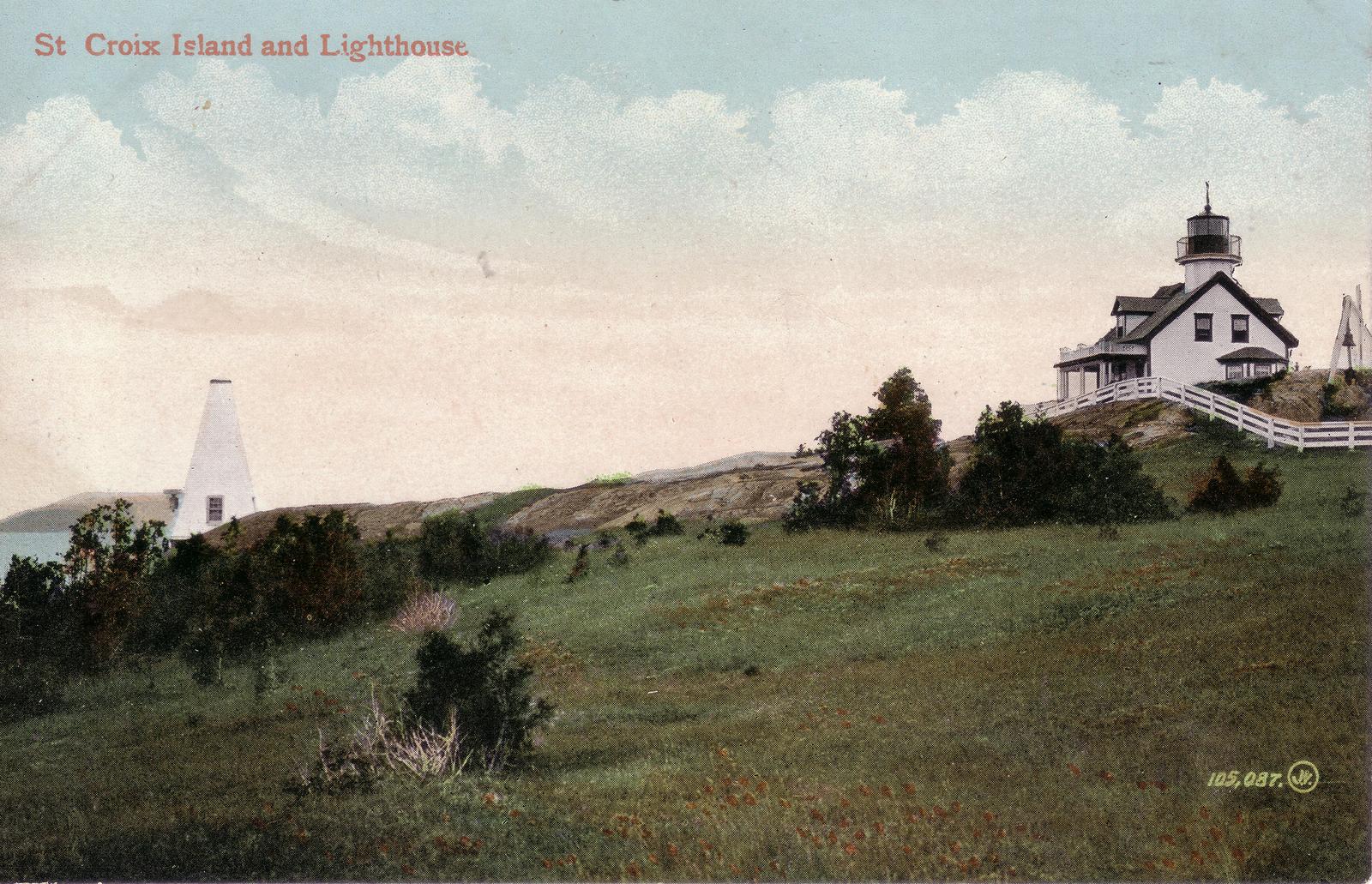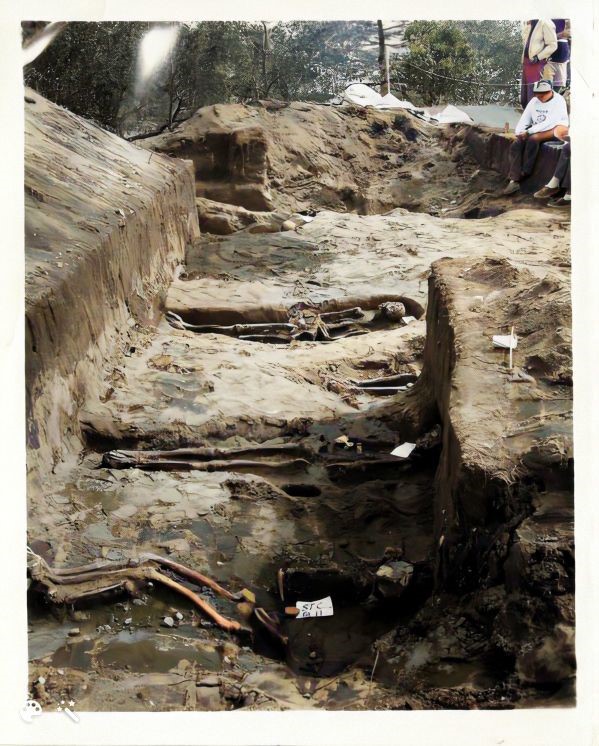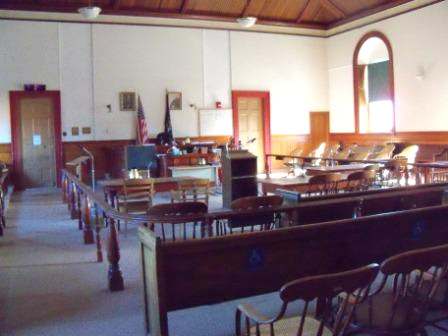
The keeper’s house and bell tower on St. Croix Island
In October 1976, I was John A. Churchill, Esquire, a pretentious title for a young, inexperienced lawyer just a year out of law school. Still, I was already accustomed to early morning calls from the Clerk of Courts, Elsie McGarrigle, an excellent clerk and delightful lady but one who ruled over “her court” like a benevolent despot. My immediate presence at the District Court on Church Street was often required to represent people who had been arrested the night before, usually for OUI, a bar fight or a domestic assault. So in late October 1976 I was not surprised when Elsie called and asked me to come to the courthouse. When I arrived, she was looking more stern than usual and she informed me that I had been appointed to represent three juveniles who, she announced gravely, had “burned the island”. The island, of course, was St. Croix Island and while the island itself was intact, the historic buildings on the island, most importantly the keeper’s house and bell tower, were charred ruins. The island was the site in 1604 of the first European settlement in the New World north of St. Augustine, Florida. The Jamestown settlers would not land in Virginia for three more years and the Pilgrims of Plymouth Massachusetts arrived only in 1620.
Nearly half of the 76 French settlers died during the winter of 1604-1605 of scurvy
Buried on the island were dozens of French explorers who had died during the brutal winter of 1604-1605. The bodies were disinterred in the 1970’s and examined to determine the cause of death which was, as expected, scurvy. The bodies were reinterred and the unmarked graveyard remains, undisturbed, on the island today.

The fire October 19, 1976
The first newspaper report on the fire was in the Bangor Daily News on October 20, 1976:
October 20 BDN
Police arrest three runaways following fire on historic island
By Karlene Washburn and Clayton Beal
CALAIS – St Croix Island a national monument at the mouth of the St Croix River between Calais and New Brunswick was the scene of a fire early Tuesday morning which destroyed the historic main building and bell tower Three juveniles from New Brunswick are being held by Calais police in connection with the fire.
It is believed by investigating police officials that the three unrelated juveniles from St Stephen NB are runaways who allegedly broke into two border area camps early this week. Reportedly taken was food, a 22 calibre rifle which was reportedly smashed and thrown into the river and a set of binoculars which were lost in the fire.
A preliminary investigation has also alleged that at about 3:30 pm Monday the three youths used a small punt to row to the island. In order to keep warm, they built a fire outside the bell tower. But because of the coldest night of the fall season, they allegedly moved inside and used some steel plates to lay on the floor of the bell tower before building a fire on the plates.
Sometime after 5 a.m. the trio were awakened by the fire which originated in the tower and was to spread to the outbuildings. SAD 77 acting superintendent Ivan Corey of Perry used the fire call box in the Red Beach area. Firemen in Red Beach and Calais responded to the alert using boats to reach the island where portable pumps were used. The Coast Guard unit at Eastport was notified at about 8:15 am and were on the scene at 10 am. But the fire was reported still active at 11 a.m.
While firemen battled the fire Calais police took the three youths into custody at 9 a.m. They will appear in Calais District Court Oct 26. Police Chief Clinton Hayward said he believed the series of events which led up to and included the fire are the semi – climax to part of a problem which police have had in the area since last spring. He said two other warrants for the arrest of two Oromocto NB men are still pending in connection with a series of break-ins at cottages on both sides of the international waterway.
County Commissioner Charles Gillis of Calais was master of ceremonies during the dedication of the island as a national monument on June 30, 1968. The dedication ceremony on the tiny island featured Sen Edmund Muskie among the speakers.
Establishment of the island as a US national monument was authorized by an act of Congress on June 8, 1949, but clearance of private ownership delayed official acceptance by the US government until the dedication date. The island was discovered and occupied in 1604 by Sieur de Monts and Samuel de Champlain as the first settlement on the Atlantic coast north of Florida. The two French explorers and a group of 100 colonists observed North America’s first Christmas on St Croix. Later in 1798 the island helped establish the St Croix River boundary between Canada and the United States.

Smuggler’s Cove, just below Devil’s Head
It soon became clear that the boys had broken into several camps on the Canadian side before crossing the river in a stolen rowboat and breaking into Frank Fenderson’s camp on Smuggler’s Cove in Red Beach. They did little damage except to his stock of liquor which they took with them when they left in the rowboat with the intention of returning to Canada but instead landed on St. Croix Island. It being late they decided to spend the night and built a fire outside the belltower to stay warm. However, the weather turned very windy and cold, and they decided to move inside the belltower where they built another fire on a metal plate and fell asleep. Early in the morning they awoke in a belltower on fire. They could only watch as a 50 MPH wind blowing in the direction of the keeper’s house spread fiery debris to the roof of the keeper’s house. Ernie Day, Calais Fire chief told the Bangor Daily:
Fire Chief Ernest Daye said Tuesday that rangers from the National Park Service visited the scene of Tuesday morning’s fire which destroyed much of the property on St Croix Island here in the St Croix River. Winds clocked at 50 miles an hour swept through the international waterway to spread flames from the island’s bell tower to the settlement’s workshop and through the main building The pumphouse was not burned. The fire was reported about 7:55 am. Three juveniles have been taken into custody by Calais police. All are from St. Stephen N.B. and are unrelated.

Calais Advertiser October 21, 1976
On the 21st of October Jay Hinson published the above photo with the following caption:
The view of St. Croix Island, with its pretty lighthouse and quaint belltower, will never be the same as a result of the actions of three 14-year-old boys from St Stephen N.B. After breaking into a dozen camps and summer homes on the Canadian shore of the St. Croix River between Waweig and St. Andrews Monday, they took a row boat and came to the American side where they broke into the cottages owned by Frank Fenderson and Ralph McLean. They reportedly took nothing from McLean’s cottage but stole a .22 rifle, a pair of binoculars and some food from the Fenderson residence. They spent Monday night on St. Croix Island. Early Tuesday morning they attempted to build a fire in the lee of the belltower, changed their minds and built it instead on some steel plates they had dragged inside the tower and fell asleep. The boys told Calais police that they were awakened by the smell of smoke and found that some logs had rolled off onto the floor, setting the belltower afire. A brisk northwest wind carried sparks over to the unoccupied and unused lighthouse, a two-story structure situated about 300 feet away from the tower and set that building afire. This all happened around 7 o’clock Tuesday morning and by 10 o’clock there was nothing left of the two structures except ashes despite the attempts by firemen from Calais and Red Beach to extinguish the flames. The firemen had mustered enough boats to get about a dozen men onto the island with pumps and hoses and had caught the three youths. According to local police, the three boys are being held in Bangor awaiting arraignment in court here in Calais on October 26 on charges of breaking and entering. No arson charges are to be brought against the boys, according to a representative of the U.S. Attorney’s office who was consulted Tuesday by the Calais police, because the three youths are Canadian, are juveniles and illegally entered the country. Because they are juveniles, according to local officials, no charges of illegally entering the country will be brought against them either. The destroyed lighthouse and belltower are more than a century old and were in the process of being refurbished by the federal government -in advance of development of the island as a national monument in 1979 when a sightseeing boat will be traveling to the island from Red Beach. (Hinson photos)
Of course I was aware of the fire as it was the talk of the town. I also drove by the island every day on my way to work. Like the rest of the community was appalled at the loss of the buildings on the island but as the boys were being held in Bangor and I had not yet been appointed in the case I had to follow the developments in the papers. However, I was a classmate and friend of John Romei, the Assistant District Attorney, who, like me, had one year experience before the bar. He had been handed a very tough case and I was aware he hoped the Federal Government would prosecute the three boys but was making little headway with the Federal prosecutor.
Bangor Daily News October 21, 1976:
Tentacles of authority tightens on 3 runaways.
MACHIAS – Assistant District Attorney John Romei here has indicated that three juvenile boys who are alleged to have broken into two camps in the Calais area in addition to allegedly causing the fire which destroyed three structures on St Croix Island Tuesday may not be prosecuted by federal authorities for the damage to the national monument island.
The three 14-year-olds were transported to Penobscot County Jail in Bangor early Wednesday morning by Calais police because Washington County does not have facilities for long term confinement of juveniles. The St. Stephen area youths are due to appear in district court at Calais on Tuesday Oct 26 for arraignment on charges of breaking entering and larceny.
Romei said “There is some question” whether they will be tried by U.S. federal authorities for the fire, but he said it is clear that federal authorities could prosecute if they chose to do so. He also said it was “unclear whether the state can prosecute.”
On Tuesday state authorities will be in conference with the Royal Canadian Mounted Police and the St Stephen NB town police concerning a variety of other alleged complaints from border area law enforcement officials.
The boys reported by the arresting Calais Police Department to be runaways from separate families are also considered to have entered the United States illegally. The US border patrol is believed conducting an investigation into that aspect of the case. The youths are being held on $500 cash bail each.
Chief of the park operations at Acadia National Park Warner N. Forsell told the NEWS Wednesday that he has inspected the fire at the island owned by the US Government. The Federal Bureau of Investigation is considering a possible arson case, but no indication has been received by his office concerning any attempt by federal authorities to prosecute the New Brunswick youths. “I wouldn’t be overly optimistic about seeing them prosecuted” he said.
Forsell who supervises the St Croix property under the Acadia Park region said that two of the structures were in the 1856 era of construction and both were destroyed by the fire which started in a third part of the complex, the bell tower built in the early 1900’s. The tower was 30 feet high and 15 feet square at the base. It was considered a navigational marker. The lighthouse (26 by 22 ft) was a two-story frame structure adjacent to a 24 by 25-ft single-story building.
Outbuildings not burned were described as an oil storage house and boathouse.
In the end the Feds made it quite clear they did not intend to prosecute the boys for illegal entry into the country or any offense related to the destruction of the building on St. Croix Island. This left only the breaking and entering charges in Calais and St. Stephen.
Calais District Court
On November 5, 1976, a most unusual special session of the Calais District Court was held in the district court over the Calais City Building. Presiding was Judge Jessie Briggs, later one of the most respected judges in the state but then only 28 years of age and appointed only in January to the bench. Representing the State of Maine was John Romei, Assistant District Attorney with, as noted above, a year of experience before the bar and your writer with the same experience. It would have been unusual for a single attorney to represent all three defendants, but I cannot recall any other defense attorney being present although it is quite possible each boy had his own attorney. The voice of experience in the courtroom was Judge Douglas Rice, a judge with years on the bench and highly respected lawyer from St. Stephen who presided over the Charlotte County Court in the St. Stephen area. The proceedings may have been unique-an international tribunal of sorts unauthorized by any rule or statute in any of the three jurisdictions with authority to prosecute the boys. By then the Feds had made it clear they wanted nothing to do with the case. This left only the Province of New Brunswick and State of Maine to sort it out.
Clint Hayward, Calais Chief of Police was most unhappy at the presence of the Canadians, unfriendly to Judge Rice and the Mounties who accompanied the judge and bitterly opposing any outcome which did not include incarceration of the juveniles in Maine. Hayward was a “tough on crime” cop for whom leniency was never appropriate. He felt the boys should have been charged with arson and, if not charged with the crime, at least sentenced as arsonists. This is somewhat ironic as he later served several years at Thomaston State Prison for burning his North Street apartment building to collect the insurance.
Legally it was clear the juveniles could either be prosecuted in Maine for breaking into two camps or in New Brunswick for breaking into several camps. The Feds weren’t interested in prosecuting and everyone except Chief Hayward agreed the juveniles were not guilty of arson. Breaking into unoccupied camps by juveniles was a pretty common occurrence on both sides of the river and unless the culprits had prior records often warranted only a probationary sentence. Lengthy discussions followed on the best way to proceed. Judge Rice assured Judge Briggs that he felt the offenses warranted some term of incarceration and based on those assurances, my client(s) pleaded guilty to breaking into the Fenderson and McLean cottages. They were put on probation and remanded to the custody of the Mounties who marched them out of the courtroom under the baleful eye of Chief Hayward. In defense of Chief Hayward many in Calais felt the boys should have been prosecuted in Maine.
On November 22, 1976, Judge Rice tried the three juveniles in St. Stephen. The Bangor Daily reported the outcome:
Juveniles sentenced in N.B.
ST STEPHEN NB – A spokesman for the office of Judge Douglas Rice here in this St Croix River community near Calais said Friday that three juveniles who appeared in District Court in Calais earlier this month have been sentenced to serve terms in the youth training center at Fredericton N.B. On Nov 5 at Calais Maine District Court Judge Jessie Briggs made a special appearance to consider the case in which the three youths had been charged with breaking entering and larceny. The youths were believed to have entered several camps on the shoreline of the St Croix River. The Calais Police Department headed the investigation after apprehending the juveniles on Oct 20 on St Croix Island which had been declared a national monument. A fire on Oct 20 destroyed several buildings on the island. Charges involving the alleged burning of the island’s buildings were dismissed in District Court at Calais. Charges against the three dealing with two break – ins at cottages in Calais were also heard by Judge Briggs. The youths were adjudicated to have committed the break – ins and were placed on probation and ordered turned over to Canadian court authorities for execution of sentences. The St Stephen NB spokesman identified the juveniles on Friday as Sheldon Bell, Randy Rockwell and John Green all of the St.Stephen N.B. area.
The 14 – year olds were sentenced to sentences of eight months definite plus 10-months indefinite in the Youth Training Center Fredericton on complaint of “theft and breaking entering and theft.”
Court records show that Bell was on Nov 5 to have committed 17 offenses, Rockwell 15 offenses and Green 14 offenses.

The island as it looks today
The punishment the juveniles received from Judge Rice was consistent with what would have been expected had Maine retained jurisdiction. Nonetheless local sentiment for a more severe sentence was understandable given the importance of St Croix Island to the heritage of the St. Croix Valley.
The National Park Service continues to do a wonderful job preserving the history and heritage of St. Croix Island. A visit to the park’s museum and interpretive displays is a worthwhile way to spend an afternoon.


